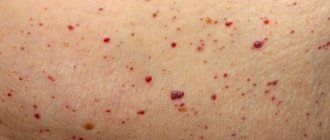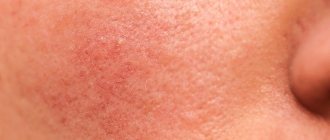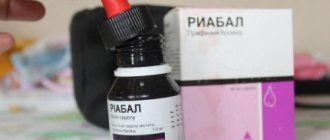Allergy on the face in the form of red spots is a common problem with which patients often turn to dermatologists. To clarify the exact cause of this condition most often requires time and a number of additional studies. To alleviate the condition of allergic dermatitis, modern antiallergic drugs are used, which include Cetrin.
Symptoms
It is quite easy to suspect an allergic reaction in yourself or your child. In addition to the presence of an allergic rash on the face, the following complaints are noted:
- Severe itching or burning;
- Dryness, flaking of the skin;
- Swelling of the eyelids, lips;
- lacrimation;
- Itching and redness of the eyes.
The rash itself may be in the form of red spots or blisters filled with transparent contents. Sometimes an allergic rash looks like small grouped dots that rise above the surface of the skin. If the rash appears after consuming any product, then symptoms may include nausea, vomiting, diarrhea, and abdominal pain1.
Color of the skin
Look to see if any changes have appeared on your face, such as swelling or hyperpigmentation. Skin color is very important in assessing health.
Straw color.
If you have a straw complexion, you need to do a biochemical blood test. The symptom often signals a vitamin B12 deficiency.
B12 deficiency is obvious if a set of symptoms is present:
- lips have a straw tint;
- epigastric pain occurs;
- there is a burning sensation of the tongue;
- depression is present.
B12 deficiency can be expressed not only by a discolored complexion, but also by other symptoms.
Gray complexion.
A grayish tint to the face appears in people with chronic lung disease and in smokers. However, in the latter, chronic lung pathology occurs most often.
Smokers should regularly undergo spirometry testing to diagnose the disease. And if your skin color has taken on a gray tint, you need to get checked immediately.
Paleness of the skin.
Pale facial skin indicates anemia or low blood pressure. The condition is especially noticeable with temporary drops in pressure.
Redness.
If the face turns red, this may indicate pressure surges. When it comes to experiencing strong emotions, the problem is temporary and does not pose a danger.
With constant redness of the face with simultaneous redness of the conjunctiva, a comprehensive diagnosis is required, including a set of specialized cardiological studies. Such symptoms are caused by vascular diseases and heart problems.
But redness in the form of symmetrical spots on the nose and cheeks, resembling the shape of a butterfly, is one of the initial manifestations of lupus, one of the most dangerous and formidable kidney diseases.
Hyperpigmentation spots
. If the spots are brown and appear randomly, mainly on the forehead and cheeks, these are rather symptoms of impaired liver function. A blood test should be done for so-called liver tests.
In this case, it is recommended to exclude from the diet:
- coffee and alcohol;
- fats;
- spicy spices;
- foods with saturated and trans fats.
If the spots are symmetrical and appear on the upper lip, then the condition often indicates hormonal disorders.
Causes
The main reasons for the appearance of red spots on the skin of the face:
- Direct skin contact with an allergen (cream, face mask, decorative cosmetics, soap, jewelry, etc.);
- Food allergies;
- Allergy to medications;
- Allergy to sun or cold;
- Eczema1.
To prevent the appearance of a rash in the future, it is necessary to accurately determine the cause of the allergy and eliminate contact with this substance.
MECHANISM OF KERAINIZATION IN NORMAL AND IN HYPERKERATOSIS
Normally, as a result of their vital activity, skin cells gradually move from the lower layer to the upper, while gradually accumulating keratin - a protein that makes them more durable and resistant to external influences. The top layer of skin is nothing more than completely keratinized cells or horny scales, which are peeled off and replaced with new ones during human life. Such cells lack viability, but at the same time, thanks to keratin, they provide protection to living cells located underneath them from negative environmental factors.
With the development of hyperkeratosis as a pathological condition of the skin
- on the one hand, there is an active accelerated division of epidermal cells that produce keratin;
- on the other hand, there is a delay in the process of normal physiological exfoliation of horny scales from the surface layer of the skin.
Contact dermatitis
Contact dermatitis rashes are most often localized on the hands or face. An allergic reaction can be triggered by:
- Skin care products. It is important to pre-test creams, masks, lotions and other new products by applying a small amount of product to the inner surface of the forearm for 15-20 minutes.
- Decorative cosmetics. Contains a large number of coloring pigments, fragrances and preservatives. People with sensitive skin prone to dryness and irritation are more prone to allergic reactions.
- Plant pollen. When pollen from plants to which a person is allergic comes into contact with the skin, a rash, itching and other unpleasant symptoms may appear.
Red spots may appear either immediately after contact with the allergen or after some time (usually within 24-48 hours). If you find the cause of the allergy in time and stop using the inappropriate product, then no negative health consequences will be noted.
Facial swelling
A slight swelling of the facial tissues, which persists constantly, most often indicates the initial stage of an endocrine disease - hypothyroidism. Pigmentation quickly disappears after taking thyroid hormone - thyroxine.
Mild and persistent swelling of the face, which is accompanied by shortness of breath and swelling of the legs, usually in the ankles, as well as frequent getting up at night to go to the toilet, indicates circulatory failure and poor heart function.
When swelling of the face is accompanied by pallor, and visits to the toilet are very frequent, but urination is scanty, kidney disease can be suspected.
It is very dangerous when fluid accumulates only in the upper lip. If the swelling is accompanied by a feeling of tightness in the chest, difficulty breathing, then this is an allergic reaction - Quincke's edema!
The condition can become a serious threat to life. In this case, an ambulance is needed.
Allergies to foods and medications
Food allergies on the face are quite common, especially in children. The most allergenic foods are peanuts, eggs, seafood, citrus fruits, and dairy products. However, in the presence of individual intolerance, an allergy can develop to any other food product.
Main symptoms:
- blotchy rash on the face or body;
- Severe itching;
- Peeling of the skin;
- Nausea, vomiting;
- Stool disorders;
- Abdominal pain.
Another important problem is drug allergies. An allergic reaction may occur to a medicine in the form of a tablet, injection, or ointment. Allergies to antibiotics, antiseptics, and nonsteroidal anti-inflammatory drugs are common. The symptoms are the same as those of a food allergy. In severe cases, complications such as angioedema or anaphylactic shock may develop2. You need to know what drugs you are allergic to and warn doctors or medical staff about it.
The nose is red - it's the liver
It is generally accepted that a red nose appears in people who hardly eat while drinking alcohol. It's more of a joke. Although, indeed, when drinking alcohol, the nose becomes red.
But how to evaluate it when the nose is red and the person does not drink? Typically, a red nose indicates liver damage. This suspicion is confirmed by erythema on the inner sides of the palm. Spider veins appearing on the forehead also indicate problems with the liver.
And if a network of thin vessels previously appeared on the chest, arms or shoulders, then these symptoms indicate significant liver damage. A visit to the doctor in such a situation should under no circumstances be postponed.
ONLINE REGISTRATION at the DIANA clinic
You can make an appointment by calling the toll-free phone number 8-800-707-15-60 or filling out the contact form. In this case, we will contact you ourselves.
If you find an error, please select a piece of text and press Ctrl+Enter
Allergy to sun or cold
Natural factors can also cause the development of allergic reactions. Photoallergy or sun allergy most often occurs in the warm season - from late spring to early autumn. Sometimes an allergic rash is confused with sunburn, but the allergic nature of the disease is characterized by severe itching, the appearance of small, white pustules, and spotty red rashes even after a short stay in the open sun. In such cases, you need to apply sunscreen, protect exposed skin with clothing made from natural fabrics, and wear a hat3.
Allergy to cold or cold urticaria also occurs. During the cold season, red itchy rashes, peeling, and a feeling of tightness appear on the skin of the face and hands. Symptoms may persist for several hours or several days after exposure to the cold. Typically, allergies develop at temperatures from 10 degrees below zero, but it also happens at temperatures close to zero.
Infectious pathologies
Various pathogens can provoke the development of infectious inflammation of the skin - bacteria, fungi, viruses or parasites. This form is characterized by an acute course, which can turn into a chronic form. The patient needs immediate medical attention.
In its acute form, the most common erythema infectiosum in children is caused by parvovirus B19. It is characterized by the sudden onset of the disease, the characteristic signs of which are:
- rapidly rising body temperature;
- muscle pain, headache;
- the appearance of a red rash covering the face and body on the third or fourth day after the onset of the disease;
- gradual increase and closure of spots.
After some time, clinical manifestations gradually fade away until they disappear completely. If left untreated, the process can become chronic. The patient remains able to transmit the infection to healthy people for several days after recovery.
Eczema
Eczema is an inflammatory skin disease that tends to be chronic and relapsing. Often the symptoms of eczema are confused with allergic reactions, since the rashes can be similar in appearance. Eczema is characterized by the appearance of bright red spots and swelling of the skin. Grouped bubbles with transparent contents appear on a red background, after which crusts form.
The occurrence of the disease is associated with mechanical damage to the skin, microbial or fungal infection, and occupational hazards. Complex immune reactions characteristic of allergies also take part in the development of pathology.
Diagnosis of sun allergy
If you notice an unusual reaction to the sun, I recommend contacting an allergist or dermatologist, who will prescribe you a certain range of analyzes and tests that can be used to confirm the presence of an allergy or a predisposition to it.
It is impossible to fight a disease without eliminating its causes, so be prepared to be offered a comprehensive examination:
- skin tests (scarification tests, prick tests, patch tests). Skin allergy tests are the fastest, safest and most reliable method of examination in immunology. Testing is carried out for patients from 5 to 50 years old;
- determination of the level of total immunoglobulin E;
- determination of the level of specific immunoglobulin E to household, epidermal, pollen, fungal, food, medicinal and bacterial allergens, as well as insect poison;
- determination of the level of specific immunoglobulins to food antigens - diagnosis of food intolerance;
- examination of sputum and secretions from the nasal cavity.
Treatment
Treatment for facial allergies must include a safe and effective antihistamine3. Cetrin is widely used for seasonal allergies and various forms of allergic dermatitis. The main active ingredient of the drug is cetirizine hydrochloride, which is a histamine antagonist. The advantages of the drug include:
- Quick effect. Onset of action 20 minutes after administration.
- Duration of action. The drug is taken once a day and is effective for 24 hours.
- Good tolerance. Cetrin is well tolerated by patients and causes less drowsiness than first-generation drugs1.
The drug helps eliminate itching, swelling, and redness of the skin. Available in tablet form, approved for use in children over 6 years of age. If you suspect an allergic rash, taking Cetrin is a simple, safe way to make you feel better before you can see a doctor.
Phymatous form (rhinophyma) –
Phymatous changes are called thickening of the skin (mainly in the nose area) - with the appearance of roughness, irregularities, and nodules on it. The thickening can be pronounced and then it leads to partial disfigurement of the face. Occurs more often in men, because they are less likely to seek medical help in the early stages of the disease. Thickening of the skin of the nose is called rhinophyma. Rarely, the phymatous form can be observed on the chin, forehead, cheeks, ears and eyelids.
Also, with this form, telangiectasia and hyperplasia of the sebaceous glands can occur. In the dermal layer of the skin, a dense inflammatory infiltrate is observed, in place of which then, for example, tissue proliferation and fibrosis occurs with the formation of nodes. There are several histological types of rhinophyma, for example, fibrous, glandular, fibroangiomatous, etc.
Treatment regimens for the phymatous form –
| Expressiveness | Treatment |
| Mild course - an increase in skin thickness, but without changes in contours |
|
| Moderate flow - there is a change in contours, but without a nodal component | In addition to the above:
|
| Severe flow - there is a change in contours with a nodal component |
Rhinophyma: removal of excess tissue with a CO2 laser
Treatment for red, scaly spots on the face
To choose a treatment method, you need to donate blood for tests and scrape the flaky area of skin. A dermatologist may prescribe these tests for you. It is not advisable to choose a treatment method for red spots on your own.
Proper nutrition
Treatment of red, scaly spots on the face should begin by eliminating from the diet all foods that can provoke an allergic reaction.
Such food products include citrus fruits, honey, sweets, dairy and flour.
But you need to enrich the menu with healthy foods: fruits, seasonal vegetables, nuts and unpolished cereals.
Use of medications
First, let's look at medications used directly on the skin itself to treat spots on the face.
- Ointments and creams with antiallergic effects. For example: traumeel, gistan, elidep.
- Hormonal ointments: acriderm, advantan.
- Skin antiseptics: chlorhexidine, boric or salicylic acid.
- Soothing and healing medications: zinc ointment, tincture of chamomile and calendula.
- Ointment or lotion for cell restoration - curiosin.
- Ointments for the treatment of bacterial infections: tetracycline and erythromycin ointment.
- For fungal skin infections, antimycotic ointments are used.
Now let's look at drugs that have a complex effect on the entire body.
- Sorbents that remove waste and toxins from the body: enterosgel, lactofiltrum, activated carbon.
- Antihistamines that relieve allergy symptoms: suprastin and zodak.
- Calming drugs that help relieve stress and nervous tension: tincture of peony and motherwort, glycine, valerian.
- Vitamin and mineral complexes that increase the overall immunity of the body. The complex should contain vitamins A, B (the entire group), C, zinc, magnesium and calcium.
Healing procedures
In addition to medications, cosmetic procedures are often used to treat red, scaly spots.
- Ozone therapy is a method based on the direct effect of ozone on the disease-causing area. This procedure is very popular and effective. It involves the process of introducing ozone gas into the affected area. The ozone molecule consists of three oxygen atoms. The introduced oxygen increases local immunity and has an antibacterial effect.
- Mesotherapy is an injection treatment method. Its essence lies in the fact that a meso-cocktail consisting of hyaluronic acid, plant extracts and vitamins is injected under the skin.
- Peeling - this method is based on “burning” the top layer of skin with various mild acids. Dead cells are exfoliated, and in their place metabolic processes in the skin are normalized. Pigment spots peel off along with dead particles of the epidermis. The skin becomes smooth and fresh.
- Cryomassage is a massage with cold or nitrogen. During the procedure, the surface of the face is cooled by low temperatures (from -70 to -130 degrees). The effect on the skin is very short-term, so no frostbite of the skin occurs. Thus, the response of the receptor layer of the skin is triggered.
Traditional methods of treating red spots
In addition to the above methods, there are remedies that you can make yourself at home.
- Cucumber juice – you can wipe your face with it several times a day. This lotion will help get rid of many cosmetic problems.
- Oatmeal mask - this mask is made from oatmeal, water and a few drops of lemon juice (20g of oatmeal, 10ml of water and 2 drops of lemon juice). You need to keep it on your face for 15 minutes.
- Cabbage mask helps nourish the skin. To prepare it, you need to finely chop the cabbage leaves and apply the mixture for 15-20 minutes.
- An infusion of birch buds will help relieve inflammation and redness of spots. The infusion is prepared from 1 tbsp. spoons of kidneys and 250 ml of hot water. A cotton pad must be moistened in the solution and applied to the stain. You need to hold it for 10 – 15 minutes.
- A mask of sour cream and parsley juice will soften and moisturize the skin. To prepare it you need to mix 2 tbsp. spoons of sour cream and 1 teaspoon of parsley juice. Apply the mask to your face and leave on your face for 15 minutes.










